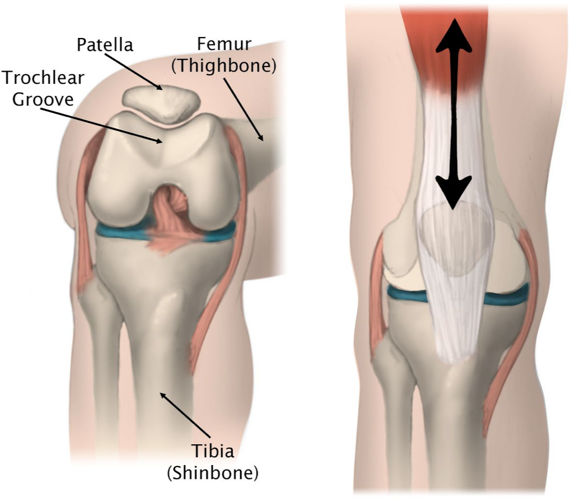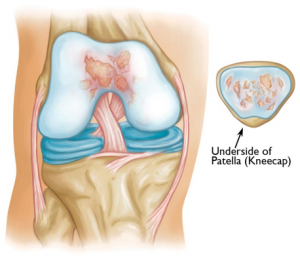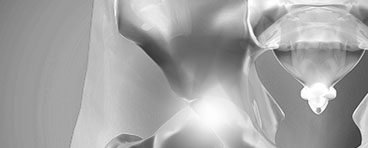Click on the links below to find out more
Patellofemoral Replacement
OVERVIEW
During knee replacement surgery, damaged bone and cartilage is resurfaced with metal and plastic components. Patellofemoral replacement is a type of “partial” knee replacement in which only a portion of the knee is resurfaced. The procedure is an alternative to total knee replacement for patients whose damaged bone and cartilage is limited to the underside of the patella (kneecap) and the channel-like groove in the femur (thighbone) that the patella rests in. In many cases, this allows patellofemoral replacement patients to recover faster and return to normal activities more quickly than total knee replacement patients.
ANATOMY
Your knee is divided into three major compartments:
- Medial compartment—the inside part of the knee
- Lateral compartment—the outside part of the knee
- Patellofemoral compartment—the front of the knee between the patella (kneecap) and femur (thighbone)
Within the patellofemoral compartment, the patella lies in a groove on the top of the femur called the trochlea. When you bend or straighten your knee, the patella moves back and forth inside this trochlear groove.

(Left) A normal knee joint. The medial, lateral and patellofemoral compartments are shown. (Right) An x-ray of a normal knee showing healthy space between the bones.
A slippery substance called articular cartilage covers the ends of the femur, trochlear groove, and the underside of the patella. Articular cartilage helps your bones glide smoothly against each other as you move your leg.
In knee arthritis, the cartilage protecting the bones of the knee slowly wears away. As the cartilage wears away, it becomes frayed and the underlying bone may become exposed. Moving the bones along this rough surface is painful. This can occur throughout the knee joint or just in a single area of the knee.
Advanced osteoarthritis that is limited to the patellofemoral compartment may be treated with patellofemoral replacement. During this procedure, the underside of the kneecap and the trochlear groove are resurfaced with metal and plastic implants. The healthy cartilage and bone, as well as all of the ligaments in the rest of the knee, are preserved. Often this is in patients who have had longstanding problems with their kneecap dislocating or maltracking, in these patients additional procedures are often required to restore the alignment and path the kneecap runs it.

(Left) The patella rests in a small groove at the end of the femur called the trochlear groove. (Right) As you bend and straighten your knee, the patella slides up and down within the groove.

(Left) This x-ray shows a normal knee from the side. The arrows point to the normal amount of space between the bones. (Right) This x-ray shows narrowed joint space and bone rubbing on bone due to arthritis.

(Left) This x-ray shows a normal knee from the side. The arrows point to the normal amount of space between the bones. (Right) This x-ray shows narrowed joint space and bone rubbing on bone due to arthritis.
Advantages of Patellofemoral Replacement
Potential advantages of patellofemoral replacement over total knee replacement include:
- Less blood loss
- Quicker recovery
- Smaller surgical incision / less surgical trauma
- Decreased complications
- Increased knee function and activity
In addition, because the bone, cartilage, and ligaments in the healthy parts of the knee are kept, many patients report that a patellofemoral replacement feels more natural than a total knee replacement.
One advantage of patellofemoral replacement over total knee replacement is that healthy parts of the knee are preserved, which helps to maintain more “natural” function of the knee.
Disadvantages of Patellofemoral Replacement
The primary disadvantage of patellofemoral replacement compared with total knee replacement is the potential need for more surgery. For example, a total knee replacement may be necessary in the future if arthritis develops in the parts of the knee that have not been replaced.

Dr David Slattery
FRACS MBBS (Hons) LLB FAOrthA
Dr David Slattery is an orthopaedic surgeon based in Melbourne with over 10 years of experience, with a special focus on hip and knee joint preservation and replacement. With qualifications in both medicine and law, he brings a unique and comprehensive approach to patient care. His surgical techniques are minimally invasive and evidence-based, designed to reduce pain and enhance recovery.
Trained in leading institutions across Europe and the USA, Dr Slattery offers advanced treatments for a wide range of joint conditions. He is deeply committed to patient outcomes and takes pride in tailoring treatment plans to each individual. Whether you’re an athlete or seeking relief from chronic joint pain, his goal is to restore function and improve your quality of life.







